Spin-offs of Wordle are abundant now, and they come in all shapes, sizes, and themes! Clones aside, there are quite a few Wordle variants that live up to the creators’ desire to drive the players to the edge.
But we must admit, the worse the difficulty level, the more we commit to the game. It is the challenge, exactly, that gives us the kick. Considering the interest, we present to you another cute but biting Wordle variant today. Let’s go ahead and greet Waffle!
What is Waffle, the waffle-like Wordle game?
Waffle is one of the youngest siblings in the Wordle variant family. Created by James Robinson, a developer based in Portsmouth, Waffle, at a glance, is Wordle in the form of a crossword puzzle that resembles a waffle in shape. It is a puzzle of multiple 5-letter hidden words that you have to unscramble using the available hints (letters and colored feedback) within the available number of chances.
I made a game in the shape of a waffle and it is called "waffle"https://t.co/Ka41WRPa3a
— James Robinson (@JamesJessian) February 13, 2022
An objective analysis forces me to say that Waffle may not be entirely unique in terms of structure and format in the Wordle universe. After all, we have met the older siblings, Crosswordle and Squardle before. However, Waffle exudes quite an appeal with its ability to cripple your in-game maneuvers within its waffle-esque grid. We shall study its attributes shortly, but let’s cover the basics first.
Related: How to Play Crosswordle: Rules and Gameplay Explained
Where to play Waffle?
Waffle, like Wordle, is an online game that can be played by anyone on the Internet. All you have to do is go to wafflegame.net on a web browser and close the instruction-guide pop-up to start playing. One of the many similarities it shares with Wordle is that Waffle is also a daily word game.
Waffle game link: wafflegame.net.

There are multiple avenues to get to the game owing to its characteristic as a web-based game. The requirements are limited to the possession of any smart device (mobile phone, tablet, smart TV) or PC/Desktop, access to the Internet, and any web browser of choice like Google Chrome, Safari, or Opera.
Related: Wordle Unlimited Games: Play Wordle More Than Once a Day and More With These Tips
How does Waffle work?
Waffle is Wordle presented in a grid that takes after a waffle in appearance. What greets you upon entering the game is an assembly of checkered tiles arranged both vertically and horizontally to form a square that resembles a crossword puzzle. Some tiles are green, some yellow, and some gray, and all the tiles carry a letter each.
Evidently, the game bears only minor resemblance to the muse game, Wordle, owing to the now-familiar scheme employed of green, yellow, and gray colored hints. On Wordle, the gameplay is all about making new guesses to figure out the secret word of the day. However, on Waffle, there is not one but 6 hidden words that are strewn about in a tortuous route.
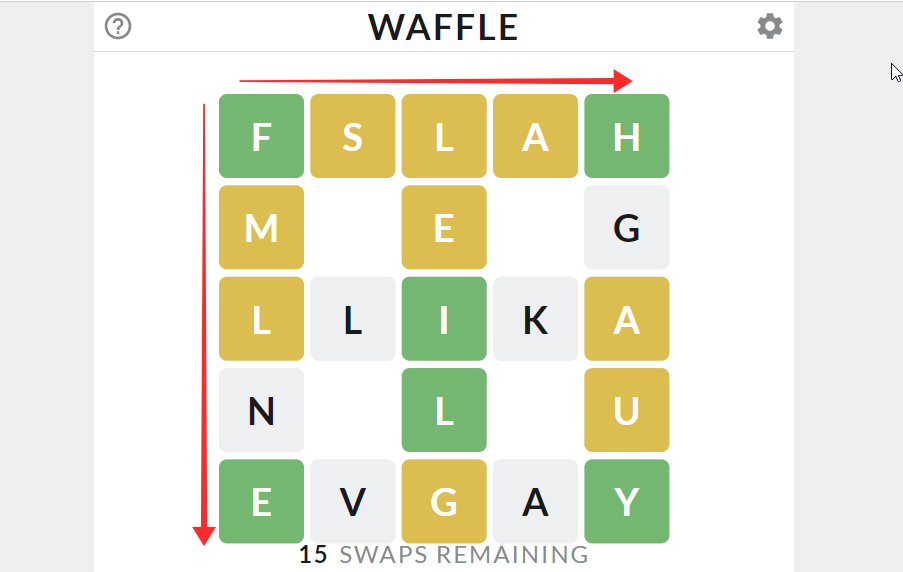
There are 6 hidden words in all, each 5-characters in length per challenge — 3 hidden vertically and 3 horizontally, and you get 15 Swaps in total to move the misplaced “yellow” and “gray” letters to find their right order in relation to the “green” letters affixed to their spots.
Even though the structure and gameplay show conspicuous deviation from the original Wordle, if you are familiar with its rules, then it means that you have the rudimentary elements of Waffle already ingrained in you.
Related: Wordle Game Rules: List of Every Rule in Wordle [Explained]
Allow me to mention here an interesting new element to the game (unrelated to the gameplay itself). At the end of a challenge, Waffle entails the added feature of a curated dictionary of the hidden words (of the current game) with an intention to enlighten the players of their origin, meaning, and usage. Waffle is thus an entire meal of a word game that more than whets your appetite, but feeds you with intense challenges and enriching knowledge.
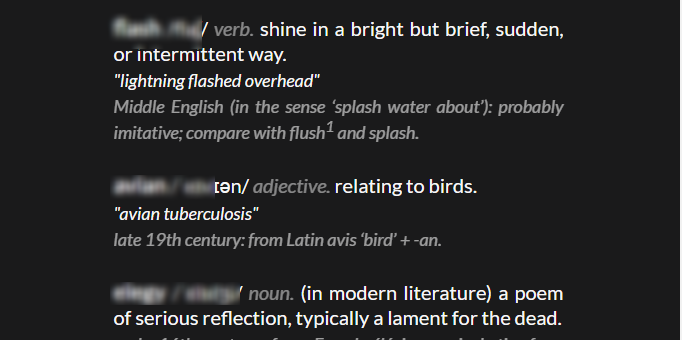
The concept of colors and the idea of unraveling the hidden word mirror in Waffle, but your gameplay requires some serious rethinking and replanning if you wish to crack the game. Let’s review the game rules before we delve deeper into the gameplay and strategies.
Waffle Rules: Everything You Need to Know
Waffle is a daily word game; all players on a given date get the same scrambled grid of “green”, “yellow” and “gray” letters, and it resets every day to present a new challenge (as indicated by the timer that pops up at the end of each challenge).

There are 6 (5-letter) hidden words on a Waffle grid. All the letters are available in a jumbled form on the grid, with some information already available about the position of the letters in the rows and columns. Your progress in the game is bound to the act of switching the position of the wrong letters to find the right order.
The catch is the upper limit set on the total number of available chances. With only 15 swaps at your disposal, the odds of encountering an abysmal fail are higher if you don’t make your moves wisely. However, it is fortunate that swapping across rows and columns is not restricted at all in the game. So, it all boils down to your ability to plan your moves. You also need an entirely new set of strategies than what works on Wordle to ace at Waffle.
The colors signify the same on Waffle as they do on Wordle. If an available letter is already enclosed in a green tile at the beginning of the game or it turns green upon swapping positions, it means that it has found its correct position. The green letters get locked in the tile once recognized by the system. The yellow tiles indicate the partially correct nature of the letters in a row or column.

Awareness of the rows and columns and the letters in each condition is crucial to decipher the system hints. For instance, when you consider a row in isolation, the yellow letter(s) in it reveals its sure occurrence in the row, but in a different position. The same is true when you study a column as an independent unit.
However, the wiggly element on Waffle is the crossroads. If you find a yellow letter that is stationed at the junction of a row and column, then it indicates that it could be a part of either. Under such circumstances, you need to envision multiple scenarios of solution words to avoid wasting the available swaps.
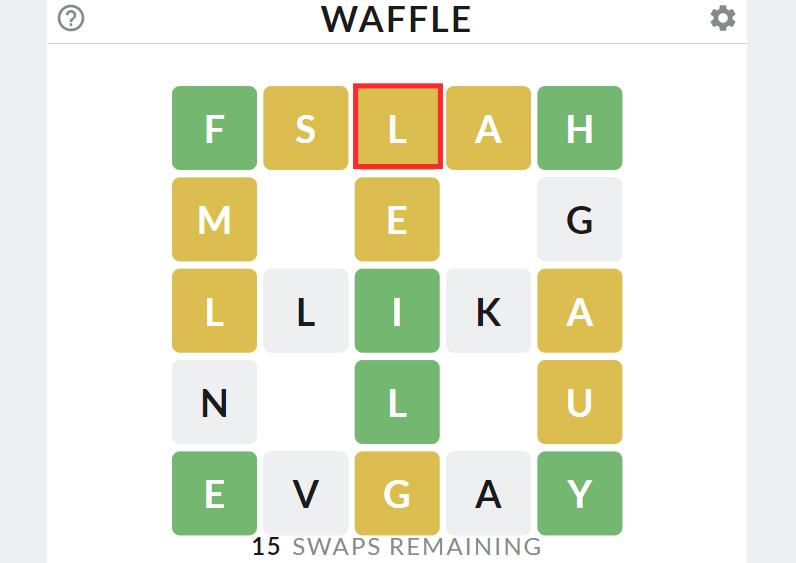
How to play Waffle
SPOILER ALERT: The following section contains the answer to the Waffle challenge, dated February 24, 2022, as a part of the explanation.
Waffle opens to reveal quite a bit of information to the players through multiple “green” and “yellow” letters in the grid and the “gray” (misplaced but surely present) letters. Your challenge is to undertake smart letter swapping. Let’s study the hints available on the Waffle challenge of February 24, 2022, to break down the gameplay, and workable strategies step-by-step.

As can be seen in the screenshot, the game begins with a tease that gives a vague impression of the hidden words. There are 6 “green” letters already on the grid, with 4 of them occupying key positions in the hidden words (the starting and ending positions). When Row 1 is considered separately, apart from the two “green” letters in the starting and ending positions, the remaining three letters of the word are “yellow” which reveal their existence in the row.
If you commit your attention to those rows or columns that reveal significant information, at least enough to make an informed decision, it could translate to a good start in the game. The ability to grok the grid is essential in the Waffle game.

But, it can’t be that breezy and easy to solve, for even if one or two rows/columns can be consecutively solved (with many swaps to spare), the remaining jumble could still remain vague. One of the reasons is the sheer number of “acceptable” — not “solution” — words. Here’s where strategy comes into play on Waffle.
Waffle Strategies and Tips
Most strategies you apply on Wordle are moot on Waffle, for the gameplay doesn’t allow for fresh entries of words; rather it only accepts the rearrangement of the available letters in a different order. So, the best starter words that you swear by and common letters that you favor shall be kept aside for the time being.
It doesn’t mean vowels and letter positions are irrelevant to the gameplay, it’s the opposite! They matter the most! The main information that you need to gather from a grid at all points is the location of the vowels, and which letters take the starting and ending positions.
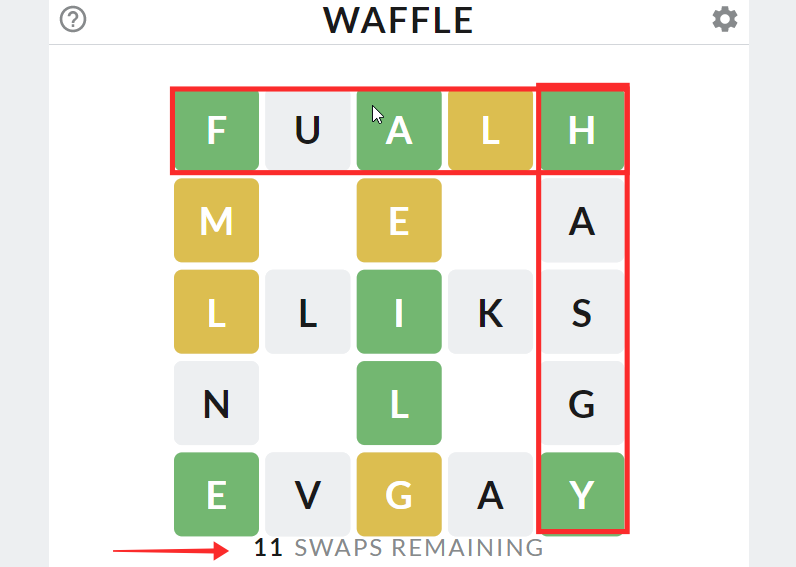
Waffle doesn’t involve any keyboard input. But, you need to be aware of the letters, all the same, especially the ones that do not appear at all in the hidden words. The absence of the keyboard makes it a bit challenging to keep track of the letters, and that could lead you astray on the grid or force you to make wrong guesses.
However, you cannot afford to make futile maneuvers on the grid — always keep an eye on the number of swaps remaining. The game allows free and unrestricted swapping of “yellow” and “gray” letters across the rows and columns, however, if you make aimless swaps, that will only exhaust the available chances. The trick is to not make hasty conclusions about the hidden words, but take slow but steady steps towards the more obvious words.
As the hidden words on Waffle are five-letter words, a confusion that is bound to crop up during the game is the occurrence of multiple acceptable words. Observe the screenshot for reference — here, Row 3 already shows an acceptable five-letter word (“ALIGN”), but it is not the solution word (“AVIAN”). At the same time, Column 3 almost dittos the letters on Row 3 but the position of the “green” letter “N” in the last position on Row 3 makes it impossible for “ALIGN” to be the hidden word in Column 3 as well.

The tip to implement is saving on swaps at such a juncture. Wordle is all about planning and implementation– for that, you need to get in touch with your intuition and also take the old route of visual mapping on the side. Do not be shy to bring out a pen and paper to scribble down word scenarios based on the available information and usable letters.
Waffle, much like Wordle, is a game of deduction but on a much-condensed scale. That doesn’t eliminate the possibility of letters repeating in a game. Multiple letters may repeat across various rows and columns in the grid. Pay attention to the system feedback to ascertain the occurrence of repeating letters on a row or column.
Let’s take an instance. In the screenshot below, we can see that “L” appears 4 times in a single challenge grid. Depending on their relative position, each repeated “L” is given different feedback (green, yellow, and gray). The colored feedback for the letters changes (excluding the locked “green” L’s) depending on your moves until they get locked in the correct position.
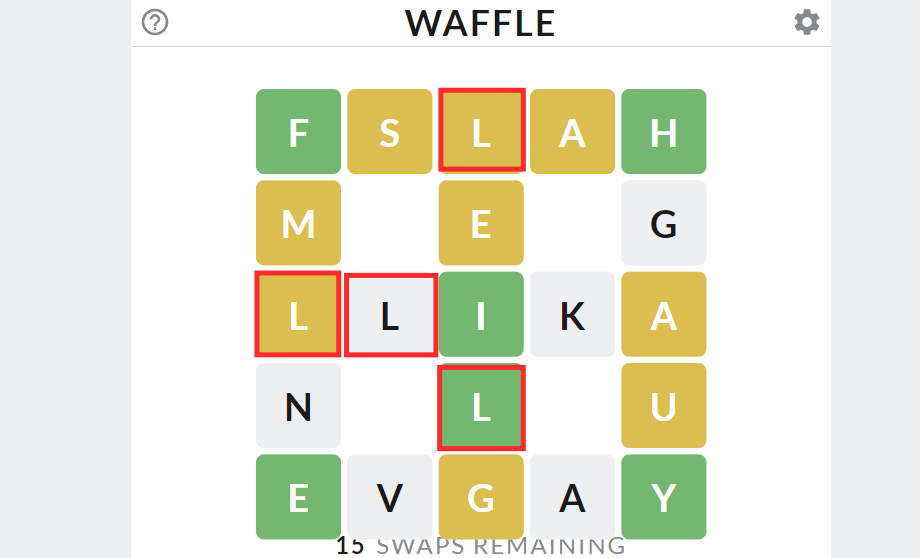
As all the letters on a Waffle grid are valid in the game, the gray feedback only indicates the absence of the letter in the row or column under consideration. Your follow-up moves should factor in multiple answers at once to make each move count.
Waffle Help: How to search for words for Waffle
The trick to solving a Waffle grid in fewer moves is resorting to word game helper tools or websites. Keep a side-tab open for gaining easy access to websites like Wordhippo or any search engine. So, how do we make use of these assistants? Let us run a practical test with a scrambled Waffle grid.
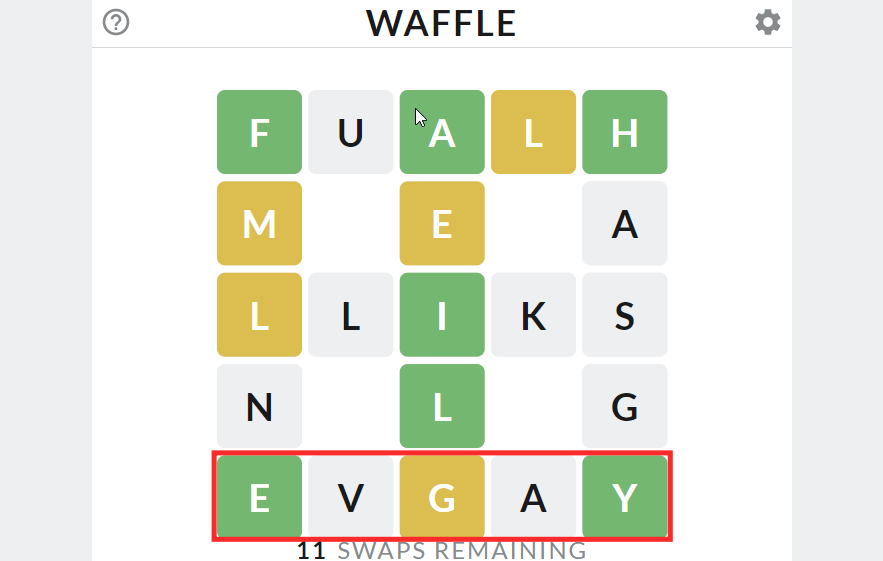
In the screenshot above, we can see that Row 5 has two “green” letters (“E” and “A” respectively) stationed in principal starting and ending positions. 2 out of the 5 letters in the hidden word on the Row are “gray” which exacerbates the overall foggy visibility of the hidden words on the grid. We only have 11 moves to spare, which adds to the pressure.
How do we make headway? Here’s where helper webs and tools come in handy. Open a search engine, say Google, and type “five-letter words starting with “E” and ending with “Y”. Of course, the “results” page will show more words than can be applied. So we employ our sharp eyes and keen observation skills to use!
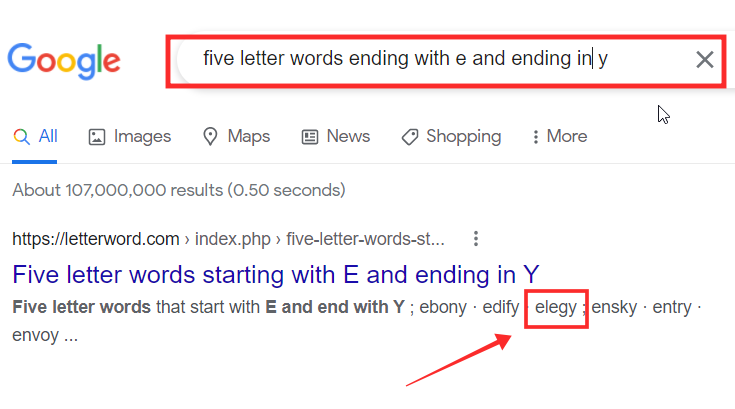
From what can be gleaned, the useable letters on our grid are limited to “L” and “G”. The letters like “D”, “F”, “B”, “T”, “S” or “O” are invalid in the grid and hence such words shall be directly crossed out. Thus, our word list gets narrowed down significantly by the process of elimination.
Word game helper websites are a dime a dozen; we have explored a few like Wordhippo or Word.tips in detail in the article linked below.
Related: 8 Best ‘Wordle Helper’ Websites and Tips
Plain old Google might do the job just fine, however, word game helper websites have more advanced filters to fine-tune your query to get a condensed word list. If you wish to limit your searches to a search engine, make sure that your queries are crisp and detail-oriented.
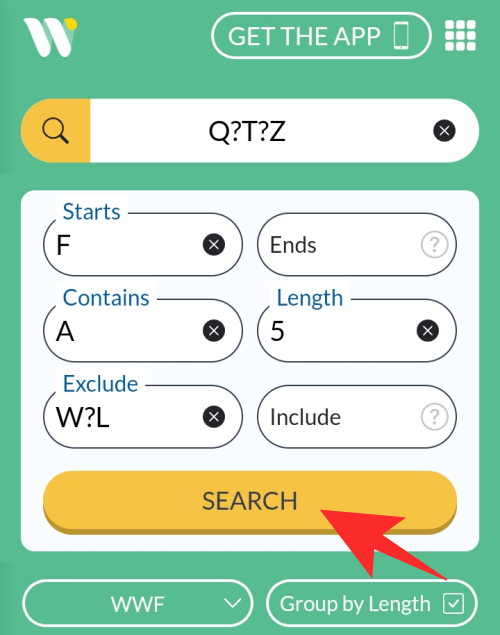
Since Waffle is closer to a crossword than Wordle, helper websites for crosswords might help you finish the puzzle faster than regular word game helper websites.

Below is a compact list of websites that could help you take on Waffle in quick and easy moves:
FAQs
Does Waffle have a Hard Mode?
At present, Waffle only offers a regular, daily challenge mode without any ascribed aspect of difficulty. However, its Crossword-esque formula is dynamic enough to keep you guessing. The difficulty level varies according to the hidden words of the day — so, there could be tough days or breezy games. Regardless, it guarantees fun and intrigue.
How many challenges can you take a day?
Waffle is strictly one game a day. However, the game itself is in its stage of incipience and might see extensions and modifications in the future. Hence, the possibility of getting a hard mode or unlimited game mode cannot be ruled out. It is something to look forward to!
Does a Waffle challenge have multiple solutions?
Unlike most crossword challenges, Waffle adheres to the principle of immutability by sticking to a predetermined solution list per game. Hence, your word arrangements, even if acceptable, will not be registered by the system unless and until you make the swaps to find the right hidden word (as available in the solution list of the game). This is in stark contrast with the fluidity exhibited by Wordle variants like Crosswordle; however, it also elevates the difficulty involved in solving the puzzle without exceeding the available number of moves.
Does the Waffle game have an app?
Waffle, like Wordle, is an online game that can be played on a web browser from your smart device or Desktop/ PC. It doesn’t have an app variant available, presently. You can play it for free on the host page wafflegame.net.

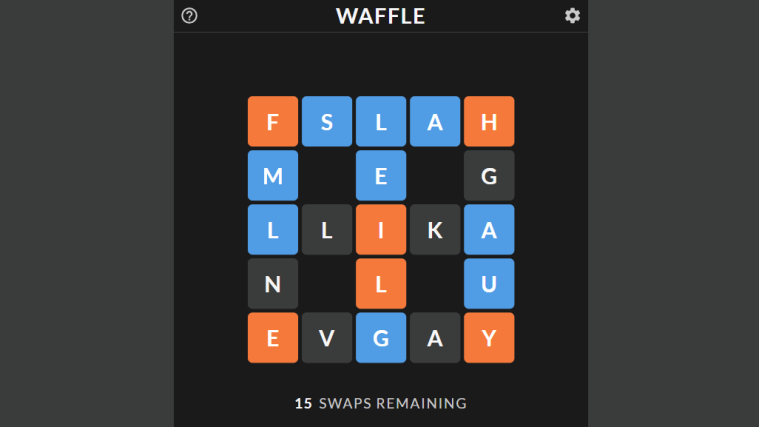




Are you able to share your results? The share icon doesn’t work for me.
Yes you can share your results with Waffle the same as you do in Wordle. I also had a few days when my Share button didn’t work but then it began to work without me having to do anything. That being said, I find if I turn my phone off for 15-20 minutes, when I turn it back on the problem is fixed so you might want to try doing that to see if it makes any difference.
I love doing the Waffle game. One question is whether the dictionary of valid 5-letter words that the program uses is public, or if the game owner can say anything about it, like how big it is?
It seems to me that Waffle can conceptually be divided into two distinct games. One game is finding the correct final layout of letters. I was able to whip together a C program to do that, based on an online “Peter Norvig” dictionary. In fact, for my first attempt I completely ignored the information conveyed by yellow letters; yellow and white were treated the same. It seems the large majority of the time the solution is unique even ignoring yellow-letter constraints, and when not unique it is likely due to obscure words in the Norvig dictionary (which has 12,000 5-letter words).
If you know the final grid, it’s a big step in solving the puzzle, but you’re not done yet!
The second game, from a logical point of view, is completely independent, and it is how to do the particular swaps you need to have 5 left over. You have 15 swaps and a perfect score is 5, so you need to do it all with 10 swaps. Suppose there are 14 white/yellow letters (which seems common). You know you can solve this in 14 by going through the non-green spaces one at a time and swapping in the letter that goes there (maybe 13 is guaranteed because the last letter has to be right?) So how to “double up” to save 3 or 4 guesses by getting a swap to put TWO letters in place For instance, if N letters are in a sort of loop, only N-1 swaps are required. In one puzzle I tried there were 14 non-green letters, and they broke down into two loops of 4 each and two loops of 3 each. I find it much harder to intuitively figure this out. Even when (in a test game) I use my program to find the correct final grid, I have to think a while to come up with the right swaps. Maybe I’m missing some fairly simple procedure?
Of course when I’m actually playing the game I’m not going to be using my program, but I still feel mystified by the swaps. I can usually figure out a few words with hints, and then know the rest of the grid, but still puzzle over what swaps to do to earn a perfect score.